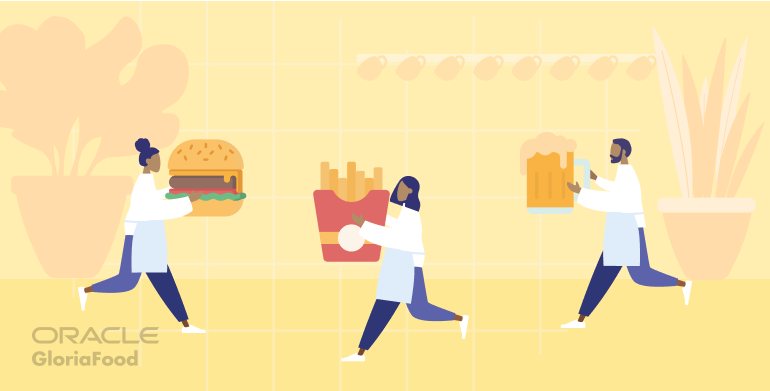- What is a restaurant strengths and weaknesses analysis?
- What are some common restaurant strengths?
- What are some common restaurant weaknesses?
- Why you must find the strengths and weaknesses of a restaurant
- A simple guide for a restaurant strengths and weaknesses analysis
- 1. Gather information about your restaurant
- 2. Analyze your competitors’ business
- 3. Assemble a trusted team
- 4. Divide the information into strengths and weaknesses
- 5. Convert the analysis into a business plan
- Final words
You may have started your restaurant because you have a passion for food, but you can’t base your business decisions on feelings, you must always back them up with data.
A restaurant strengths and weaknesses analysis can help you gather important information that you can use to better your business. In this article, you will find a short guide on how to do this analysis properly and use it to your advantage.
What is a restaurant strengths and weaknesses analysis?
Identifying restaurant strengths and weaknesses is part of a SWOT (strengths, weaknesses, opportunities, threats) analysis that business owners use to have a better look over the current state of their business.
It implies analyzing gathering and analyzing relevant information to identify opportunities to optimize your business to ensure you run a successful restaurant long-term.
The first part of strengths and weaknesses focuses on internal factors and the second one on opportunities and threats on external factors. We will focus on the internal ones in this article because you can directly manage and improve them.
What are some common restaurant strengths?
Your restaurant’s strengths are the features that attract customers to your restaurant and keep them coming back. By identifying them, you understand what clients like about your business so you can further increase your sales.
Here are some common restaurant strengths:
- A pricing strategy that keeps your restaurant profitable while clients find the food as good value for money;
- Unique menu items that people can’t find elsewhere;
- Outstanding décor that creates a great atmosphere and looks great in photos;
- A convenient location, often coupled with great views;
- The opportunity to dine outside in the favorable seasons;
- Intuitive technology that makes online ordering a breeze.
Make online ordering one of your restaurant’s strengths
Install an online ordering system to your website for free
What are some common restaurant weaknesses?
No business is perfect, and your restaurant is no exception. You don’t have to get discouraged, identifying your weaknesses will help you improve your restaurant so it will successfully withstand the test of time.
Here are some common restaurant weaknesses:
- Unsatisfactory customer service that can lead to negative reviews;
- A long waiting time both for dine-in and online orders;
- Variable food quality;
- Lack of cleanliness;
- No online presence that makes it difficult to find information about the restaurant;
- A complicated way to order online.
Why you must find the strengths and weaknesses of a restaurant
Being a restaurant owner is already a very exhausting job and you may not want to take on any additional tasks. But doing a restaurant strengths and weaknesses analysis is not optional, it is a must if you want a thriving business. Here are the benefits you will enjoy if you do the analysis every six months:
- Aids in decision-making: for example, if you want to better your online ordering process, you can take a look at what clients find difficult about it and search for ways to improve it that would be to their liking;
- Creating efficient business plans: if you want to increase your revenue, you must better your restaurant. By identifying your problem areas, you can create a business plan that will both solve the existing issues and prevent future ones;
- Surpassing your competitors: showcase your strengths and eliminate your weaknesses to convince potential customers to choose your restaurant over the competition;
- Attracting more clients: when you know what your selling points are, you can promote your strengths to persuade more customers to visit and order from your place.
A simple guide for a restaurant strengths and weaknesses analysis
Finding out your restaurant’s strengths and weaknesses doesn’t have to be complicated or time-consuming. With a bit of organization, you can get it done in just two days. Follow these steps:
1. Gather information about your restaurant
The first step is to gather as much information about your restaurant, such as what clients enjoyed about your restaurant, what they disliked, and what they would like to see improved.
Check out these easy-to-implement tips:
- Look over your online reviews: ignore the star reviews without comments and focus on longer messages, full of details. Extract the main points for them, such as the likes and complaints;
- Monitor your social media comments and messages: disgruntled or happy customers often voice their opinions on social media. Make it a habit to check and reply to messages so you can get valuable feedback;
- Ask your employees: your team is the one that constantly interacts with the customers, so it makes sense that they know what your clients think. You can allow them to send you anonymous suggestions to ensure they feel it is safe to be truthful;
- Send out a feedback form: if you want more detailed answers or want to target a specific area of your restaurant, you can send out feedback forms to gain more insights about your client’s preferences.
2. Analyze your competitors’ business
Sometimes, you don’t realize you have a weakness until you see a business that is doing better than yours. For example, a competitor may have a high table turnover, making a lot more money in a day compared to you who only serve a limited number of clients a day.
You can better compare businesses by:
- Visiting your competitors: check out their establishment during busy hours and analyze the menu, service, décor and identify if there are things clients seem to be appreciating. You may find ideas you can replicate at your restaurant.
- Checking their online presence: look over their website, google rankings, social media, and review platforms. Are they ranking higher than you? What are they doing differently and what can you do to get a better reputation than them?
3. Assemble a trusted team
Any task is easier when you can rely on a team. Moreover, it will be helpful to have different perspectives because other people may come up with helpful ideas that don’t cross your mind.
Select a small team of your most trusted employees, preferably from every aspect of the business, such as management, marketing, kitchen, and service.
4. Divide the information into strengths and weaknesses
Now that you have the information and the brainstorming team, it is time to start your restaurant strengths and weaknesses analysis. You will need a whiteboard or a document that you can divide into two quadrants, as we are not focusing on the second part of the SWOT analysis here.
Work with your team to divide all the gathered information into strengths and weaknesses. For example, if a customer commented “I really enjoyed their take on the classic pizza, you can’t find it anywhere else in town”, you can down under strengths “unique food – pizza”.
Encourage the team to also come up with ideas to better the business or solve an issue whenever you identify another strength or weakness. Don’t forget to also make note of the ideas.
5. Convert the analysis into a business plan
Use the notes you took during the meeting to create a business plan. Precisely, take the ideas, assign the responsibility of implementing them to someone, and give them the tools to do so. It is also helpful to set a deadline so you can easily monitor when things get done.
Technology will solve many of your restaurant’s weaknesses
Discover how an efficient online ordering system can help you
Final words
Doing a restaurant strengths and weaknesses tool is a must if you want to constantly better your business. Take advantage of our simple and easy-to-follow guide to come up with ideas that will make your restaurant more efficient and attract more customers.
- What is a restaurant strengths and weaknesses analysis?
- What are some common restaurant strengths?
- What are some common restaurant weaknesses?
- Why you must find the strengths and weaknesses of a restaurant
- A simple guide for a restaurant strengths and weaknesses analysis
- 1. Gather information about your restaurant
- 2. Analyze your competitors’ business
- 3. Assemble a trusted team
- 4. Divide the information into strengths and weaknesses
- 5. Convert the analysis into a business plan
- Final words








